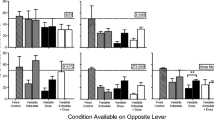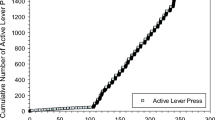Abstract
Rationale
Studies in rodents have demonstrated that increased access to cocaine can result in increases in drug intake per unit time.
Objectives
The present studies characterized long-term changes in cocaine self-administration associated with quantitatively and qualitatively different conditions of cocaine availability in monkeys.
Materials and methods
Separate groups of rhesus monkeys (n = 6/group) self-administered cocaine (0.2 mg/kg per injection) under a fixed ratio (FR) 30 schedule for 3 h twice daily for two consecutive days each week for 1 year, or responded under a second-order FR 10 (fixed interval 3-min:S) schedule of 0.2 mg/kg per injection cocaine during daily sessions. After 18 weeks, probe sessions were conducted once per week, in which responding was maintained under a fixed interval (FI) 30-min schedule in the presence of distinct stimuli.
Results
Weekly cocaine intakes under the FR schedule were stable in three subjects, but increased progressively in three monkeys over 1 year. In contrast, response rates under the second-order schedule were low and stable over time. Responding under the FI 30-min schedule was higher for monkeys in the FR group and pattern of responding was not indicative of FI performance, perhaps due to experimental history.
Conclusions
These data suggest that increases in cocaine intake can be observed under ratio schedules in monkeys. The use of an FI 30-min “probe” to assess changes in “drug seeking” appeared to be influenced by experimental history. These data may aid in the development of behavioral models of cocaine abuse, which focus on the compulsive nature of drug taking.



Similar content being viewed by others
References
Ahmed SH, Koob GF (1998) Transition from moderate to excessive drug intake: change in hedonic set point. Science 282:298–300
Ahmed SH, Lutjens R, van der Stap LD, Lekic D, Romano-Spica V, Morales M, Koob GF, Repunte-Canonigo V, Sanna PP (2005) Gene expression evidence for remodeling of lateral hypothalamic circuitry in cocaine addiction. Proc Natl Acad Sci USA 102:11533–11538
Aigner TG, Balster RL (1978) Choice behavior in rhesus monkeys: cocaine versus food. Science 201:534–535
Bouton ME (2004) Context and behavioral processes in extinction. Learn Mem 11:485–494
Bozarth MA, Wise RA (1985) Toxicity associated with long-term intravenous heroin and cocaine self-administration in the rat. J Am Med Assoc 254:81–83
Catania AC, Reynolds GS (1968) A quantitative analysis of the responding maintained by interval schedules of reinforcement. J Exp Anal Behav 24:657–665
Claytor R, Lile JA, Nader MA (2006) The effects of eticlopride and the selective D3-antagonist PNU 99194-A on food- and cocaine-maintained responding in rhesus monkeys. Pharmacol Biochem Behav 83: 456–464
Czoty PW, Martelle JL, Nader MA (2006) Influence of abstinence and conditions of cocaine access on the reinforcing strength of cocaine in nonhuman primates. Drug Alcohol Depend 85(3):213–220
Dackis CA, O’Brien CP (2001) Cocaine dependence: a disease of the brain’s reward centers. J Subst Abuse Treat 21:111–117
De La Garza R 2nd (2005) Endotoxin- or pro-inflammatory cytokine-induced sickness behavior as an animal model of depression: focus on anhedonia. Neurosci Biobehav Rev 29:761–770
Deneau G, Yanagita T, Seevers MH (1969) Self-administration of psychoactive substances by the monkey. Psychopharmacologia 16:30–48
Everitt BJ, Robbins TW, (2000) Second-order schedules of drug reinforcement in rats and monkeys: measurement of reinforcing efficacy and drug-seeking behaviour. Psychopharmacology (Berl) 153:17–30
Ferrario CR, Gorny G, Crombag HS, Li Y, Kolb B, Robinson TE (2005) Neural and behavioral plasticity associated with the transition from controlled to escalated cocaine use. Biol Psychiatry 58:751–759
Fitch TE, Roberts DC (1993) The effects of dose and access restrictions on the periodicity of cocaine self-administration in the rat. Drug Alcohol Depend 33:119–128
Gawin FH (1991) Cocaine addiction: psychology and neurophysiology. Science 251:1580–1586
Gawin FH, Ellinwood EH Jr (1988) Cocaine and other stimulants. Actions, abuse, and treatment. N Engl J Med 318:1173–1182
Gawin FH, Kleber HD (1986) Abstinence symptomatology an psychiatric diagnosis in cocaine abusers. Clinical observations. Arch Gen Psychiatry 43:107–113
Goldberg SR, Gardner ML (1981) Second-order schedules: extended sequences of behavior controlled by brief environmental stimuli associated with drug self-administration. NIDA Res Monogr 37:241–270
Goldberg SR, Tang AH (1977) Behavior maintained under second-order schedules of intravenous morphine injection in squirrel and rhesus monkeys. Psychopharmacology (Berl) 51:235–242
Goldstein RZ, Volkow ND (2002) Drug addiction and its underlying neurological basis: neuroimaging evidence for the involvement of the frontal cortex. Am J Psychiatry 159:1642–1652
Grigson PS, Twining RC (2002) Cocaine-induced suppression of saccharin intake: a model of drug-induced devaluation of natural rewards. Behav Neurosci 116:321–333
Johanson CE, Balster RL, Bonese K (1976) Self-administration of psychomotor stimulant drugs: the effects of unlimited access. Pharmacol Biochem Behav 4:54–51
Katz JL (1980) Second-order schedules of intramuscular cocaine injection in the squirrel monkey: comparisons with food presentation and effects of d-amphetamine and promazine. J Pharmacol Exp Ther 212:405–411
Mantsch JR, Yuferov V, Mathieu-Kia AM, Ho A, Kreek MJ (2003) Neuroendocrine alterations in a high-dose, extended-access rat self-administration model of escalating cocaine use. Psychoneuroendocrinology 28:836–862
Morgan D, Roberts DC (2004) Sensitization to the reinforcing effects of cocaine following binge-abstinent self-administration. Neurosci Biobehav Rev 27:803–812
Nader MA, Bowen CA (1995) Effects of different food-reinforcement histories on cocaine self-administration by rhesus monkeys. Psychopharmacology (Berl) 118:287–294
Nader MA, Reboussin DM (1994) The effects of behavioral history on cocaine self-administration by rhesus monkeys. Psychopharmacology (Berl) 115:53–58
Nader MA, Morgan D, Gage HD, Nader SH, Calhoun TL, Buchheimer N, Ehrenkaufer R, Mach RH (2006) PET imaging of dopamine D2 receptors during chronic cocaine self-administration in monkeys. Nat Neurosci 9:1050–1056
Newey WK, West KD (1987) A simple, positive semi-definite, heteroskedasticity and autocorrelation consistent covariance matrix. Econometrica 55:703–708
O’Brien CP, Childress AR, Ehrman R, Robbins SJ (1998) Conditioning factors in drug abuse: can they explain compulsion? J Psychopharmacol 12:15–22
Porrino LJ, Lyons D, Letchworth SR, Freedland CS, Nader MA (2002) Structural and functional neuroimaging of the effects of cocaine in human and nonhuman primates. In: Massaro EJ (ed) Handbook of neurotoxicology, vol. 2 Press Humana I, Totowa, NJ, pp 413–435
Roberts DC, Brebner K, Vincler M, Lynch WJ (2002) Patterns of cocaine self-administration in rats produced by various access conditions under a discrete trials procedure. Drug Alcohol Depend 67:291–299
Schindler CW, Panlilio LV, Goldberg SR (2002) Second-order schedules of drug self-administration in animals. Psychopharmacology (Berl) 163:327–344
Self DW, Choi KH, Simmons D, Walker JR, Smagula CS (2004) Extinction training regulates neuroadaptive responses to withdrawal from chronic cocaine self-administration. Learn Mem 11:648–657
Shaham Y, Shalev U, Lu L, De Wit H, Stewart J (2003) The reinstatement model of drug relapse: history, methodology and major findings. Psychopharmacology (Berl) 168:3–20
Tornatzky W, Miczek KA (2000) Cocaine self-administration “binges”: transition from behavioral and autonomic regulation toward homeostatic dysregulation in rats. Psychopharmacology (Berl) 148:289–298
Vanderschuren LJ, Everitt BJ (2004) Drug seeking becomes compulsive after prolonged cocaine self-administration. Science 305:1017–1019
Volkow ND, Fowler JS, Wang GJ, Hitzemann R, Logan J, Schlyer DJ, Dewey SL, Wolf AP (1993) Decreased dopamine D2 receptor availability is associated with reduced frontal metabolism in cocaine abusers. Synapse 14:169–177
Weiss F, Markou A, Lorang MT, Koob GF (1992) Basal extracellular dopamine levels in the nucleus accumbens are decreased during cocaine withdrawal after unlimited-access self-administration. Brain Res 593:314–318
Willner P, Muscat R, Papp M (1992) An animal model of anhedonia. Clin Neuropharmacol 15 (Suppl 1 Pt A):550A–551A
Acknowledgements
This research was supported by NIDA grants DA 14637 (MAN) and DA 016279 (BAR).
Author information
Authors and Affiliations
Corresponding author
Rights and permissions
About this article
Cite this article
Czoty, P.W., Reboussin, B.A., Calhoun, T.L. et al. Long-term cocaine self-administration under fixed–ratio and second-order schedules in monkeys. Psychopharmacology 191, 287–295 (2007). https://doi.org/10.1007/s00213-006-0665-z
Received:
Accepted:
Published:
Issue Date:
DOI: https://doi.org/10.1007/s00213-006-0665-z




